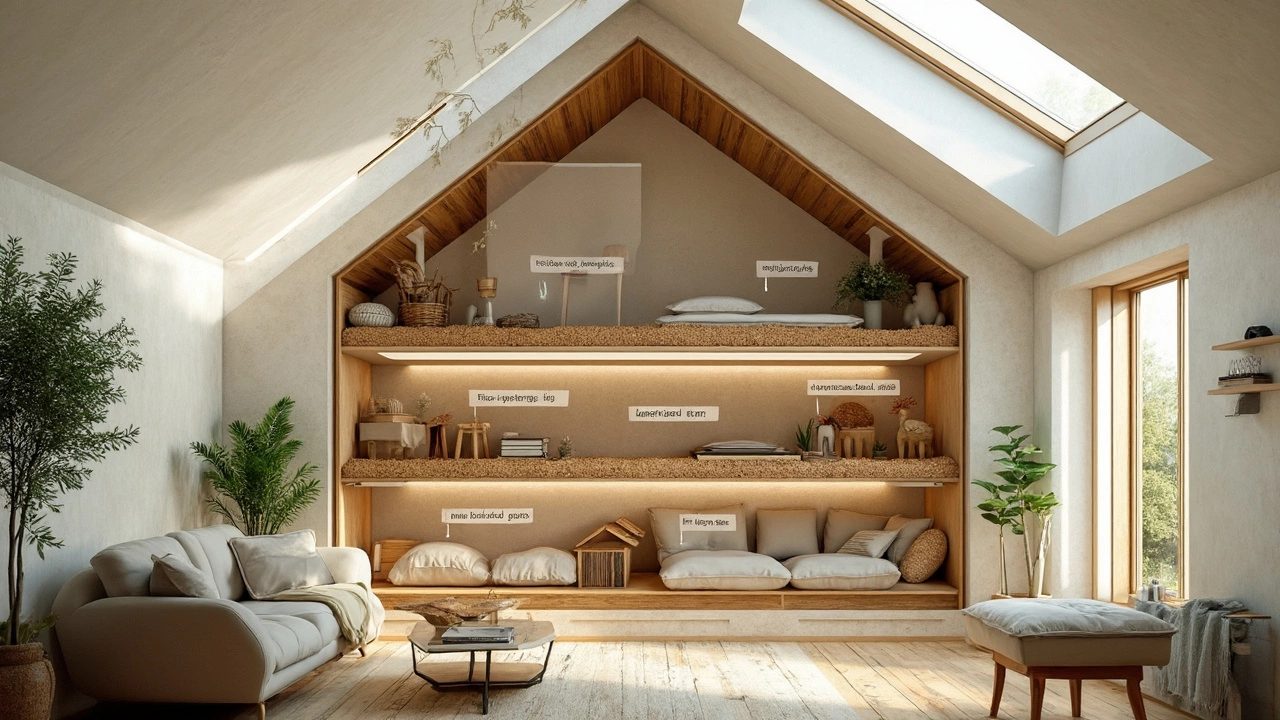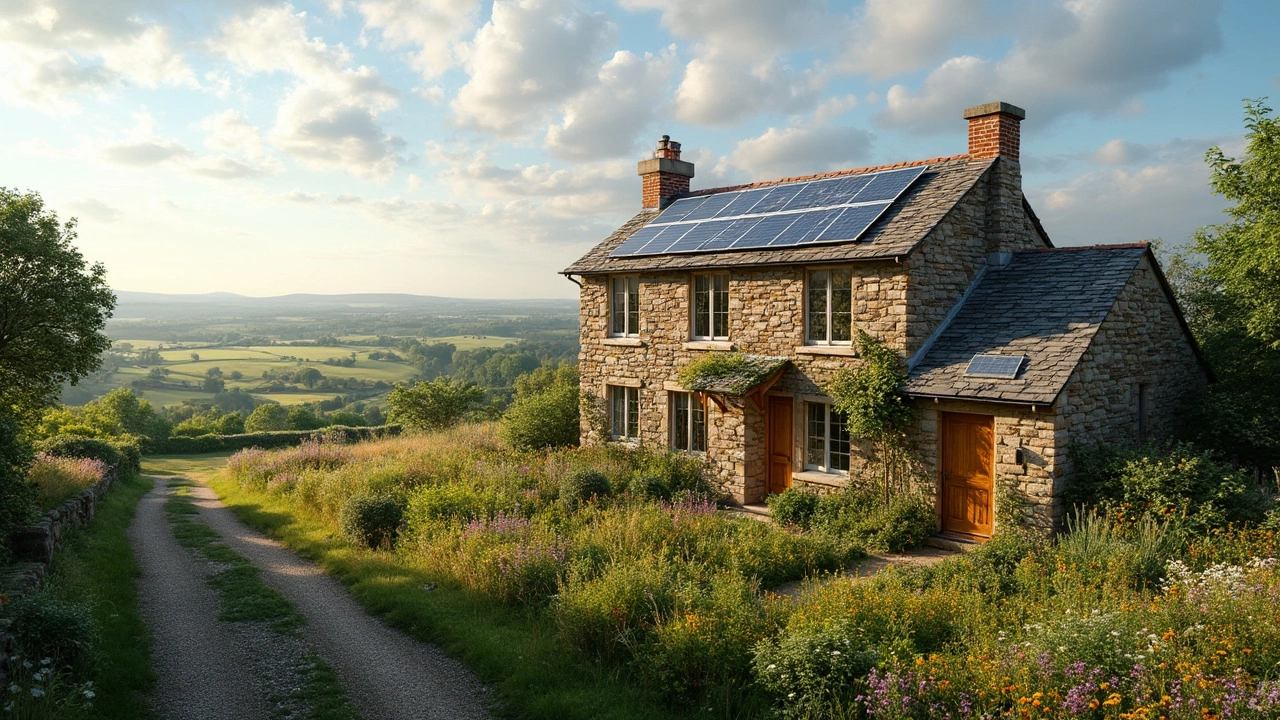Shiny labels and green buzzwords are everywhere, but when it comes to eco-friendly cottages, your building material choice actually makes a massive impact. It's more than slapping solar panels on a house—your walls, floors, and roof can either soak up carbon or quietly pollute for decades. If you want real sustainability, start at the bones of your cottage.
Forget picking a material just because it's trending on social media. The best eco-friendly building materials do three things: they have a tiny carbon footprint, use as little new energy as possible, and don't poison the planet when you're done with them. Sound simple? Wait till you see the trade-offs—some options are surprisingly old-school, while others look like they're straight out of a science fair. Picking the right one means thinking about cost, climate, and not just what’s “green” on paper, but what works right where you're building.
- Why Material Choice Matters
- Classic Naturals: Wood, Stone, and Cob
- Innovative Materials: Recycled and High-Tech Options
- Insulation and Efficiency Hacks
- Smart Building Tips for Greener Cottages
Why Material Choice Matters
Lots of folks dream about having a cozy eco-friendly cottage, but forget that the building materials matter way more than how cute the porch looks. Here’s why: materials make up most of your cottage’s total environmental footprint, from energy use to what happens when it’s finally torn down decades from now. Cut corners on material choices, and you’ll probably end up with higher energy bills, more repairs, and a bigger impact on the planet—none of which fits the whole green living plan.
Let’s get real: The construction industry is responsible for about 11% of the world’s carbon emissions. That’s not just factories or transport—it’s what the house is made of. Traditional materials like concrete and steel need tons of energy (and put out lots of CO₂) just to exist. But natural or recycled materials can cut that number down fast. For example, using sustainably-sourced timber often means that the carbon sucked up by the growing trees is "stored" in your walls instead of floating around the atmosphere.
Check out this quick snapshot of how different materials stack up:
| Material | Average CO₂ Emissions (kg per ton) | Renewable | End-of-Life Impact |
|---|---|---|---|
| Concrete | 900 | No | Hard to recycle, landfill |
| Steel | 1,800 | No | Recyclable but energy-heavy |
| Wood | –1,100* | Yes | Biodegradable, stores carbon |
| Cob (Earth/Clay & Straw) | 10-20 | Yes | Natural, breaks down safely |
| Recycled Plastics | Varies (50–600) | No | Can be re-used, some emissions in processing |
*Wood soaks up more carbon than it releases, as long as it’s from responsible forests.
If you’re serious about slashing your carbon footprint, the first decision isn’t about which fridge to buy—it’s picking strong, lasting parts to build your home with. Every choice you make (from wall insulation to roof material) adds up to less waste, less energy burned, and a home that’s actually sustainable long term. Don’t just look for green stickers—look for real-life numbers and pay attention to where, and how, your materials are made.
- Choose locally-made stuff whenever possible. It cuts transport emissions and supports your community.
- Double-check certifications (like FSC for wood), so you’re not just trusting clever marketing.
- Ask about lifespan—durable materials mean you’ll repair less and throw out less.
Bottom line: the materials you pick aren’t just bricks and boards—they shape your impact for decades. Go beyond the hype and dig into the real numbers before you build.
Classic Naturals: Wood, Stone, and Cob
If you’re trying to shrink your cottage’s footprint, classic materials like wood, stone, and cob deserve a serious look. For centuries, people have used these materials—not just because they were handy, but because they actually work and last. And when you use them smartly, you can end up with a cottage that’s tough, comfy, and way more eco-friendly than your average new build.
Let’s break down the qualities and real-world results:
- Wood is the go-to for most eco-friendly building. When it’s sourced from well-managed forests, wood can actually store carbon, not release it. Plus, it’s super insulating—logs or thick timber walls keep warmth in and cold out. Things you need to watch for: use certified sustainable wood (think FSC), and avoid pressure-treated lumber full of chemicals.
- Stone is tough as nails and basically fireproof. It needs little maintenance and has one of the longest lifespans out there. That said, quarrying and transporting it can create a lot of emissions. If you can use local stone, the footprint drops way down. Stone’s thermal mass keeps cottages cool in summer, but it needs some help with insulation in cold places.
- Cob is a mix of clay, sand, and straw. This stuff is practically dirt cheap, and people have built cob homes that lasted hundreds of years. It’s mold-resistant, naturally breathable, and perfect if you love a DIY project. The catch? Building with cob takes serious labor and is slower than tossing up prefab panels, plus it works best in dry climates unless you have a super solid roof.
Check out how these materials stack up for eco-friendly building:
| Material | CO2 Emissions (kg CO2e/ton) | Insulation (R-value/inch) | Main Pros | Main Drawbacks |
|---|---|---|---|---|
| Wood | 110 | 1.25 | Renewable, carbon storing, flexible | Needs careful sourcing, can decay |
| Stone | 250 | 0.08 | Long-lasting, low maintenance | Heavy, not great insulation, transport emissions |
| Cob | 15 | ~0.7 | Low-carbon, natural, DIY-friendly | Labor-intensive, climate limits |
Here’s a quick tip: For real eco-friendly building, mixing these materials can work even better. For example, wood framing with a cob or stone infill often boosts both insulation and strength. Plus, get creative with salvaged timber or stones from your property—cheaper and greener every time.

Innovative Materials: Recycled and High-Tech Options
If you think eco-friendly building is stuck in the past, it's time to check out what's happening now with recycled and high-tech materials. Some of these options take trash and give it a totally new job, while others are engineered from scratch to be energy-saving champs.
Let’s start with reclaimed and recycled content. Using recycled steel beams or metal roofing saves up to 75% of the energy compared to making new steel. Old glass bottles? They’re showing up as beautiful, insulating fiber in some modern wall systems. Plastic waste gets melted and pressed into decking or even fake wood beams—these can outlast real timber if maintained.
Here are a few proven options you’ll often see in cutting-edge sustainable builds:
- Recycled Steel: Strong, fireproof, and bug-proof. Producing steel from recycled scrap cuts down carbon emissions big time.
- Hempcrete: Made from hemp fibers and lime, it’s light, insulating, and actually locks away carbon as it cures. It’s not always load-bearing but works well as insulating infill.
- Structural Insulated Panels (SIPs): Fast to install and super airtight, meaning your cottage stays comfy with less heating and cooling.
- Recycled plastic lumber: This option keeps buckets of plastic out of landfills. It doesn’t rot or mold, but it can get hot in intense sun.
- Glass Fiber Insulation: More recycled content than old-school fiberglass, with similar performance but lower overall impact.
If you’re wondering how these newer materials stack up in terms of eco-impact, cost, and lifespan, check out this quick table:
| Material | Main Eco-Benefit | Estimated Lifespan | Notes |
|---|---|---|---|
| Recycled Steel | Saves 75% energy | 50+ years | Pricier upfront, lasts forever |
| Hempcrete | Locks in carbon | 30-100 years | Needs breathable walls |
| SIPs | Lowers energy bills | 60+ years | Quick to put up, less waste |
| Plastic Lumber | Upcycles waste | 25-50 years | No rot but gets hot in the sun |
| Glass Fiber | Recycled glass content | 30+ years | Easy install, non-flammable |
Here’s a tip: when you’re shopping for these materials, look beyond the "recycled" label. Ask about the actual percentage that’s reused and where the material comes from. Locally sourced recycled stuff usually leaves a smaller footprint. And always double-check if it’s easy to repair or recycle again—no point swapping one problem for another.
Insulation and Efficiency Hacks
If you want your eco-friendly building to actually feel good inside all year (and save real money), insulation needs to be right at the top of your to-do list. Here’s the thing: a lot of traditional homes leak heat through walls, floors, and roofs like a sieve. Investing in proper insulation keeps your cottage comfy and slashes your heating bills.
Natural insulation is growing in popularity, and it’s not just a fad. Sheep’s wool, for example, is breathable, lets moisture out, and resists mold—plus, it grows back every year on happy sheep. Cellulose (made from recycled newspapers) is another winner. It packs tight, costs less than some other options, and uses up what would’ve just been landfill waste. Both materials have proven track records in cold and warm climates.
If you want something a bit more future-forward, look at hempcrete. It’s a mix of hemp, lime, and water, and it does double duty as both insulation and building block. Builders like it because it locks in more CO2 than it releases during production, and it keeps things toasty without off-gassing chemicals.
Don’t forget to seal up those sneaky gaps around windows and doors. An easy win is using weatherstripping and foam sealant. These cheap fixes stop drafts before they start, making your insulation actually count.
- Use thick curtains year-round—they’re like a thermal blanket for your windows, no fancy installation needed.
- If your cottage foundation allows, add insulation under the floorboards to stop the cold from creeping up.
- Paint walls with light colors to bounce heat around the room, especially if you rely on passive solar gain.
Finally, always go for locally sourced insulation materials. They take less energy to transport and usually match your area’s climate conditions. That’s an easy sustainability win with zero downsides. Ignore the hype—what matters is long-lasting comfort, lower bills, and materials that actually help the planet.

Smart Building Tips for Greener Cottages
If you're serious about making your cottage as eco-friendly as possible, you’ve got to look beyond the label on your materials. Tiny details—like how you insulate, where you source supplies, or even how you set up the windows—can make or break your green goals.
Let’s get practical. Here are key steps to keep your project truly low-impact:
- Pick local building materials. Using what's available nearby cuts down on shipping emissions and supports your community’s economy. For example, wood from regional forests or salvaged barn boards have way fewer transport miles attached.
- Design for sunlight. In colder places, tuck big windows on the south side so you naturally warm your rooms. Deep eaves or adjustable shades can keep things cool in summer instead of cranking the AC.
- Maximize insulation. The right insulation lets you use less energy year-round. Materials like sheep’s wool, cellulose (recycled newspaper), and hemp are both natural and work just as well as synthetic stuff. Bonus: they’re easier to recycle later.
- Seal every gap. Even high-efficiency materials can’t hide sloppy construction. Tiny cracks around doors, windows, and where walls meet the roof can leak tons of heat in winter or AC in summer. Weatherstripping costs next to nothing and saves money fast.
- Think about water use. Composting toilets, gray water systems, and rainwater catchment can shrink your environmental footprint—especially if your cottage isn’t tied to public utilities. Plus, rain barrels save money and are kind of fun to use for your garden.
If you want to see how much this stuff matters, check out typical savings from using natural insulation instead of cheap foam:
| Insulation Type | Carbon Footprint (kg CO₂e/m²) | Recyclable? | Estimated Cost (per m²) |
|---|---|---|---|
| Sheep's Wool | 1.5 | Yes | $13 |
| Cellulose | 3.5 | Yes | $9 |
| Foam Board | 15 | No | $11 |
The numbers don’t lie—going natural slices your carbon impact way down, sometimes by over 80%. Plus, these materials are much easier to handle if you ever need to tear out or upgrade anything years down the road.
One last tip: if you focus on eco-friendly building from the start, everything else gets easier. You'll spend less on heating, have less maintenance, and get the peace of mind that you’re actually doing something good for the planet—without sacrificing comfort or style.
